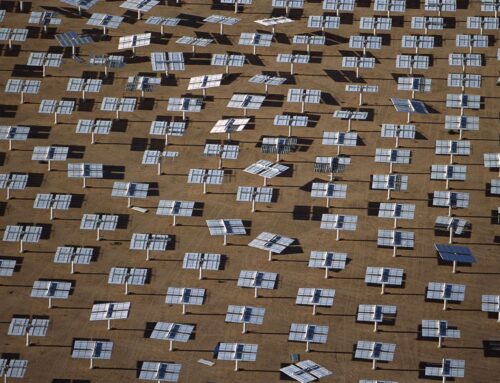When FEMA failed to test soil for toxic substances after the L.A. fires, The Times had it
May 4, 2025

On the heels of the Eaton and Palisades fires, among the most destructive urban wildfires in U.S. history, federal and state disaster agencies have refused to pay for soil testing to ensure fire-related contamination no longer remains in thousands of now-empty dirt lots across Los Angeles County.
Without this long-established precautionary measure, tens of thousands of wildfire survivors are poised to rebuild and eventually return home, not knowing if unhealthy levels of heavy metals are hidden in the soil on their properties. That leaves homeowners with a daunting choice: Pay for testing and potentially additional soil removal themselves, or live with the possibility of lingering contamination.
How concerned should homeowners be? The Los Angeles Times set out to answer that question by launching its own soil-testing initiative, modeled after the state’s sampling methodology used in previous wildfires. Journalists fanned out across Altadena and Pacific Palisades to obtain soil samples from 20 properties cleared by federal cleanup crews and 20 homes that survived; the samples were transported to a state-certified laboratory where they were tested for 17 toxic metals.
Two of the ten Army Corps-remediated homesites in Altadena still had toxic heavy metals in excess of California standards for residential properties — including one where lead levels were more than three times higher than the state benchmark. The findings are the first evidence that — by skipping comprehensive soil sampling — federal contractors are leaving toxic contamination behind.
Testing also revealed elevated levels of arsenic, lead and mercury in the yards of three homes that survived the Eaton fire — although these homeowners did not have the benefit of a federal cleanup.
These results — along with historical data from previous fires — suggest that there could be more than a thousand ostensibly remediated properties still containing toxic substances in the regions ravaged by the fires in January.
Prolonged exposure to lead — a potent neurotoxin — raises the risk of irreversibly stunting cognitive development in children and inflicting serious kidney damage in adults. Mercury is a neurotoxin and can impair respiratory, kidney and mental health at high levels of exposure. Arsenic is also a known carcinogen — and ingesting high levels can be fatal.
Gardeners are at particular risk, given how often their hands are in the soil. But kids are at the greatest risk, since they are likely to play in yards with contaminated soil and put unwashed hands in their mouths.
Although soil testing has been carried out as a precautionary measure after every major wildfire in California since 2007, this time the Federal Emergency Management Agency and Army Corps of Engineers have only agreed to remove hazardous ash and up to a 6-inch layer of topsoil from destroyed properties — but not to test what toxic substances might remain.
FEMA officials now insist it’s not the agency’s responsibility to meet California’s health standards for private properties. They argue their current cleanup procedures are sufficient to rid properties of fire-related contamination.

A worker sprays water to minimize dust as soil is excavated from a house that burned in the Mountain fire in Camarillo.
(Michael Owen Baker / For The Times)
The Newsom administration has urged federal officials to reconsider their decision to forgo testing, underscoring the state’s concern for the potential health risks to returning residents and construction workers. But the state has not committed to pay for testing, either. The city of Los Angeles has also not stepped in to fill the void.
Los Angeles County is the one government body that has arranged for some soil sampling. But it has made clear that the purpose is to gain a general understanding of the situation, not to inform individual homeowners about the condition of their property.
Jane Williams, executive director of nonprofit California Communities Against Toxics, said that the county has a duty to inform homeowners of their test results.
“Without effective hazard communication, you don’t give people the option to make good choices. It’s beyond wrong. It’s immoral.”
The collective failure to uphold these critical disaster-recovery protocols sends a chilling message to future disaster victims in California and across the U.S.: You’re on your own.
In California — the state that faces the greatest wildfire risk in the nation — these decisions could foist thousands of dollars in additional costs on homeowners or leave wide swaths of residential areas subject to extensive soil pollution.
“The ramifications are huge,” said Greg Kochanowski, co-chair of the local chapter of the American Institute of Architects’ wildfire disaster response task force. “California becomes the poster child for a lot of this, because of the amount of fires that we do have. But we’re seeing fires in New York, in Florida — all over the country. This is a national issue that I think has implications on all state budgets.”

Historic communities, like Altadena, are particularly susceptible to poisonous fallout, due to aging housing stock that still carries the legacy of lead paint and other toxic building materials.
Lupe Sanchez has called Altadena home for nearly 50 years. In 1976, as a young mother of two, she left Los Angeles’ frenetic Echo Park neighborhood for the tranquil and tight-knit community in the foothills of the San Gabriel Mountains. Her family bought a 1925-built wood-framed home, and then fixed it up with stucco and an expansive garden of citrus trees and flowers.

The soil tested at Lupe Sanchez’s home in Altadena yielded high levels of lead.
(Myung J. Chun / Los Angeles Times)
On Jan. 8, 2025, as the Eaton fire rolled over the hillside and started encroaching on their block, her family had no choice but to evacuate. When they returned weeks later, they were relieved to see that their home had survived, albeit with serious smoke damage. But a detached backhouse on her property — where she hoped her daughter would live some day — was destroyed and her lawn was coated in ash and soot.
Like 85% of property owners in Altadena and Pacific Palisades, Sanchez signed up for the Army Corps cleanup, which typically involves the removal of fire debris and up to a 6-inch layer of soil. Federal contractors soon cleared away the debris from the roughly 400-square-foot plot of land. Afterward, she expected the property to be free of harmful levels of contaminants.
The Times tested her land, taking multiple 4-inch-deep soil cores from across the property. The results: lead levels of 290 milligrams per kilogram of soil (mg/kg) in the footprint of the detached building. Her yard, left untouched by cleanup crews, contained 210 mg/kg. The state health standard is 80.
Sanchez, a retiree on a fixed income, is now trying to negotiate with her insurance company to see if it will cover the cost of removing the contaminated soil — work that is typically performed by government cleanup crews. She’s already been disappointed by a $34,000 insurance payout that is supposed to help her rebuild her backhouse — proceeds, she said, that will barely cover the cost of materials.

The Los Angeles Times tested the soil at Lupe Sanchez’s house in Altadena and found high levels of lead.
(Myung J. Chun / Los Angeles Times)
In the meantime, she struggles to reconcile what public officials say about help they claim to be offering and the assistance that is actually available.
“It’s nothing but a smoke cloud,” Sanchez said of the response from public officials. “Nothing’s being taken care of.”
“All of these 50 years, going and raising my kids, grandkids and great-grandbabies — this is their inheritance,” said the single mom.
Altadena was particularly vulnerable to postfire contamination because most homes there were built in the 1920s through 1950s — well before lead paint was officially banned in the U.S.

Ninety-six percent of properties destroyed by the Eaton fire — more than 5,300 in total — were built before lead paint was banned in 1978, according to a Times analysis of Los Angeles County assessor and California Department of Forestry and Fire Protection records. When the Eaton fire consumed these buildings, it aerosolized countless coats of lead paint — showering Altadena and areas downwind with poisonous ash and soot.
By comparison, 78% of all homes that burned in the Palisades fire were built before the lead paint ban. Out of the 20 homes The Times tested in the Palisades, only one had contamination above California standards: A standing home with elevated levels of arsenic.
Statewide, 42% of homes in California’s very high fire hazard zones were built before 1979, according to a Times analysis of Cal Fire and census data. In the L.A. area, more than 85% of Whittier, Hollywood Hills and Culver City homes with a very high fire hazard were built before the lead paint ban. Those neighborhoods would be extremely susceptible to toxic fallout in the event of a devastating wildfire.
If the Eaton and Palisades fire recoveries are suggestive of what’s to come, the costs of environmental remediation could fall on homeowners.

In Southern California, where the cost of homeownership is already among the highest in the U.S., shifting the financial burden of rebuilding safely from government and onto disaster victims will only make it more unaffordable for many current and potential residents, experts say.
“It’s not fair that people who can’t afford to spend the extra [money] to do soil testing are going to have to live with the uncertainty about whether they’ve rebuilt on contaminated land,” said Rep. Laura Friedman (D-Glendale), who led a contingent of congressional representatives that called on FEMA to reverse its decision not to fund soil testing. FEMA never responded. “It’s going to be really hard for a lot of these folks to rebuild. We’ve got a lot of folks, particularly near the Eaton fire, who were underinsured or uninsured.”
Rachel Morello-Frosch, an environmental health scientist and professor at UC Berkeley, called the government’s failure to fully remediate contaminated properties in the Altadena area a “quintessential environmental justice issue.”
“The attitude of FEMA to not test aligns with the ‘no data, no problem’ strategy of postfire cleanup,” Morello-Frosch said. “The decision not to test and not to gather evidence of potential high-level exposures — including exposures that exceed benchmarks — perpetuates inequities in post-recovery. FEMA has done this work in the past, and has used testing to guide cleanup and remediation activities post-disaster, and the fact that they’re not doing it here is just outrageous.”
Roughly 20% of wildfire-destroyed properties still have excessive soil contamination after a single layer of dirt is excavated, according to past data collected by the state. For example, after the 2018 Camp fire in Paradise, the state’s deadliest and most destructive fire in its modern history, one-third of properties — more than 4,200 — failed to meet state standards after the first scrape.

Michael Saylors tries recovering his tools after the Camp fire destroyed his home in Paradise, Calif., on Nov. 18, 2018.
(Marcus Yam / Los Angeles Times)
But in that case, as in all major wildfires in California in nearly two decades, disaster agencies ordered cleanup crews to return to remove more soil and perform additional testing on properties that didn’t satisfy those standards.
When shown The Times’ findings of contamination in Altadena soil, Robert Fenton, the FEMA administrator overseeing federal disaster response and funding in Region 9, which includes California and other parts of the Southwest and Pacific Islands, declined to comment.
The decision not to perform soil testing after the Eaton and Palisades fires was never publicly announced. It wasn’t until a Feb. 12 news conference that an Army Corps official confirmed that soil sampling would not occur — after he was asked by an L.A. Times reporter.
Since then, FEMA and the Army Corps have repeatedly declined to provide The Times with documents outlining their cleanup objectives or debris removal contracts. Public records requests from February are still pending.
It wasn’t long ago that FEMA did pay for the type of soil testing that L.A. property owners and environmental experts say is necessary now.
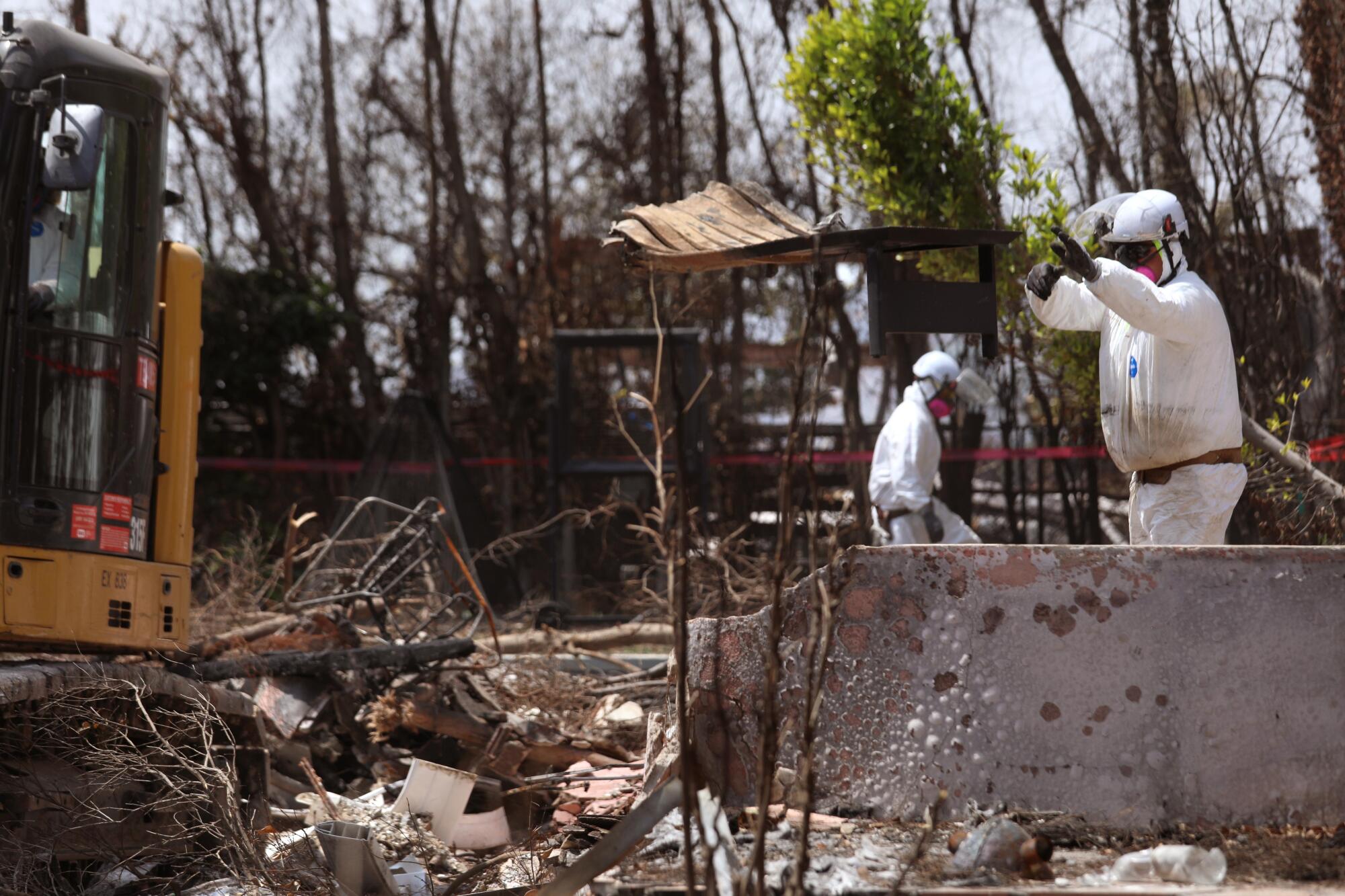
Workers clear debris from a home destroyed in the Palisades fire in Pacific Palisades. The cleanup is being overseen by the Army Corps of Engineers.
(Genaro Molina / Los Angeles Times)
But, in 2020, FEMA apparently changed its policies. That year — the worst wildfire season on record in California — Fenton, the FEMA administrator, wrote a letter to state officials informing them that FEMA would not pay for soil sampling or excavation deeper than 6 inches. The state was left to assume those costs.
Fenton has repeatedly stated that removing 6 inches of topsoil is sufficient to rid the ground of fire-related contamination. In response to questions from The Times, he cited a 2019 letter from former Environmental Protection Agency regional Superfund director Enrique Manzanilla. The brief letter did not address the nearly two decades’ worth of data contradicting that claim.
Any toxic substances found deeper, Fenton has said, is probably preexisting contamination and is ineligible for cleanup.
He also said that per FEMA guidelines, the agency is only authorized to pay for soil testing to remove the “immediate threat” after a disaster, not to aid communities in “long-term cleanup.”
FEMA and the Army Corps, however, made an exception just two years ago, after the fires in Lahaina, Hawaii. In that case, the Army Corps’ contract clearly stated that it expected 20% of properties to need up to 12 inches of soil removal.

An aerial image near Lahaina, Hawaii, where homes and businesses lay in ruins after the devastating wildfire swept through town in 2023.
(Robert Gauthier / Los Angeles Times)
Hawaii was a special case, FEMA spokesperson Brandi Richard Thompson told The Times. “At the request of the Hawaii Department of Health, FEMA approved targeted soil testing and deeper excavation as an exception, not a precedent.”
Mark Ghilarducci, former director for the California Office of Emergency Services, suggested FEMA’s policy change was driven by a desire to save money. According to wildfire cleanup experts, the typical cost for an additional round of soil testing and removal on a single property is several thousand dollars.
“The contractors that are driving these debris [removal] operations are charging a ton of money, and every time they’ve got to go in for another scrape, that’s another cost,” Ghilarducci said. “Ultimately, it comes down to dollars and cents.”
On a hot Thursday afternoon in February, Tom Purnell rested his hand on a hulking yellow excavator planted in his front driveway as officials wearing hard hats and bright yellow vests walked him through how the Army Corps would clean up the remnants of his Altadena home — at that point, essentially a pile of toxic debris.
The federal contractors told Purnell they could cut down one tree but not another. They could take out the building foundations and scrape 6 inches of soil from the footprint of his house — but no further.
“What if I buy you guys lunch?” Purnell asked. No deal.
Left unsaid was that no one would be testing Purnell’s soil for toxic metals.
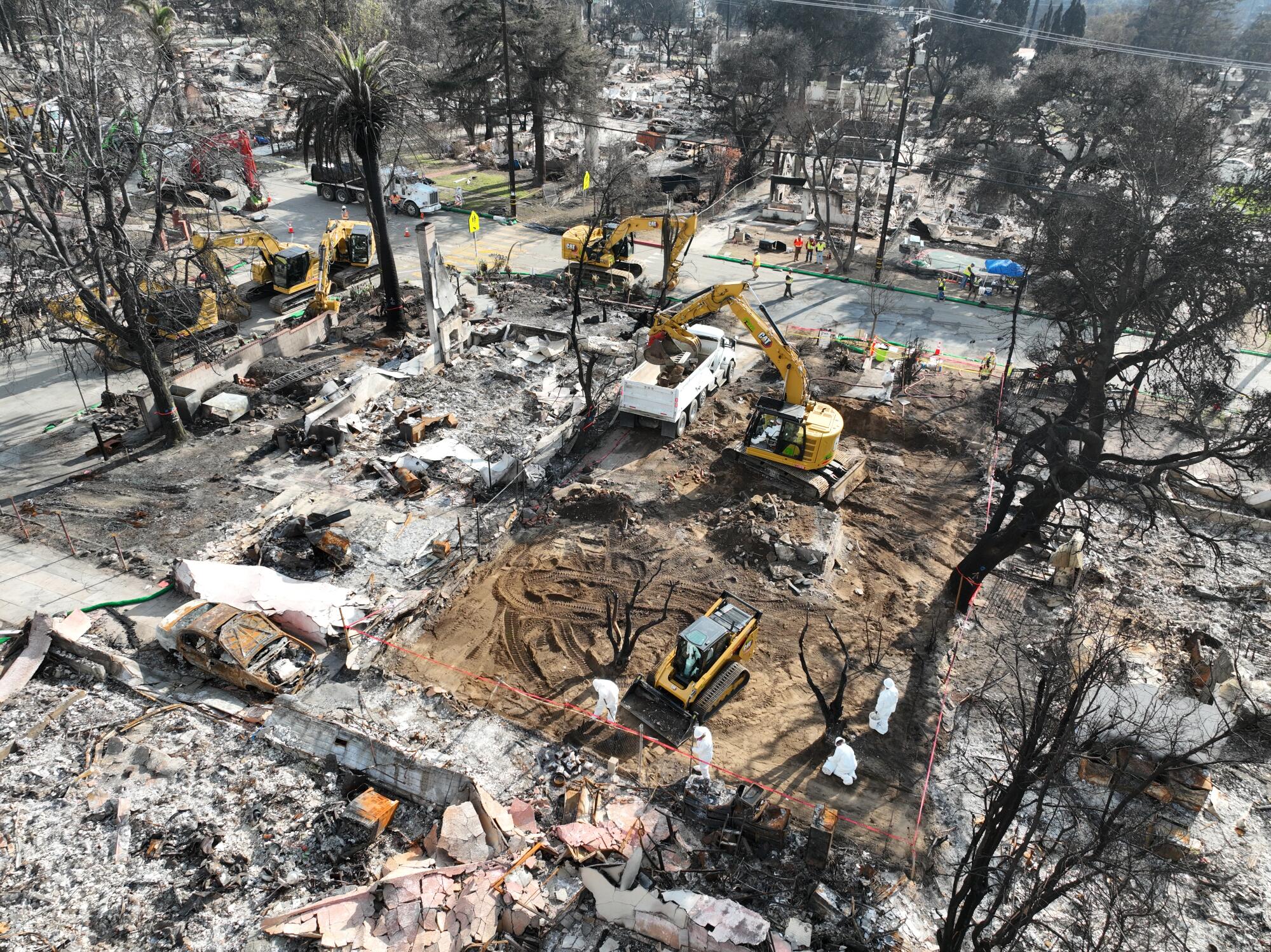
The Army Corps of Engineers clears debris from a house in the 100 block of West Palm Street in Altadena.
(Allen J. Schaben / Los Angeles Times)
Testing by The Times found that Purnell’s lot had 10 mg/kg of arsenic — double the natural levels in Altadena’s soil, according to a 2019 study by the U.S. Geological Survey.
Arsenic, a human carcinogen, has historically been used as a wood preservative and in pesticides, batteries and electronics. But it also occurs naturally in California soils.
For this reason, it’s often difficult to distinguish contamination from natural deposits. In the aftermath of a fire, disaster agencies have traditionally recommended removing enough soil to return a property to levels naturally found in the burn area.
Adam Love, a scientist hired by the L.A. County Health Department to conduct soil testing, said he wouldn’t consider anything below 12 mg/kg as a potential sign of fire contamination. That level represents the very high concentrations of arsenic that can naturally be present in Southern California, according to a 2020 state study.
However, because geology is highly variable, natural arsenic levels in many parts of Southern California are much lower — the average in the study was roughly 3 mg/kg.
In the case of the Palisades and Eaton fires, there is no target goal — the policy is to simply remove up to 6 inches of soil, and not check how much arsenic remains. Experts say there is no safe level of arsenic exposure.
Without clearly stated standards for residential soils, some academic experts have tried to fill the void.
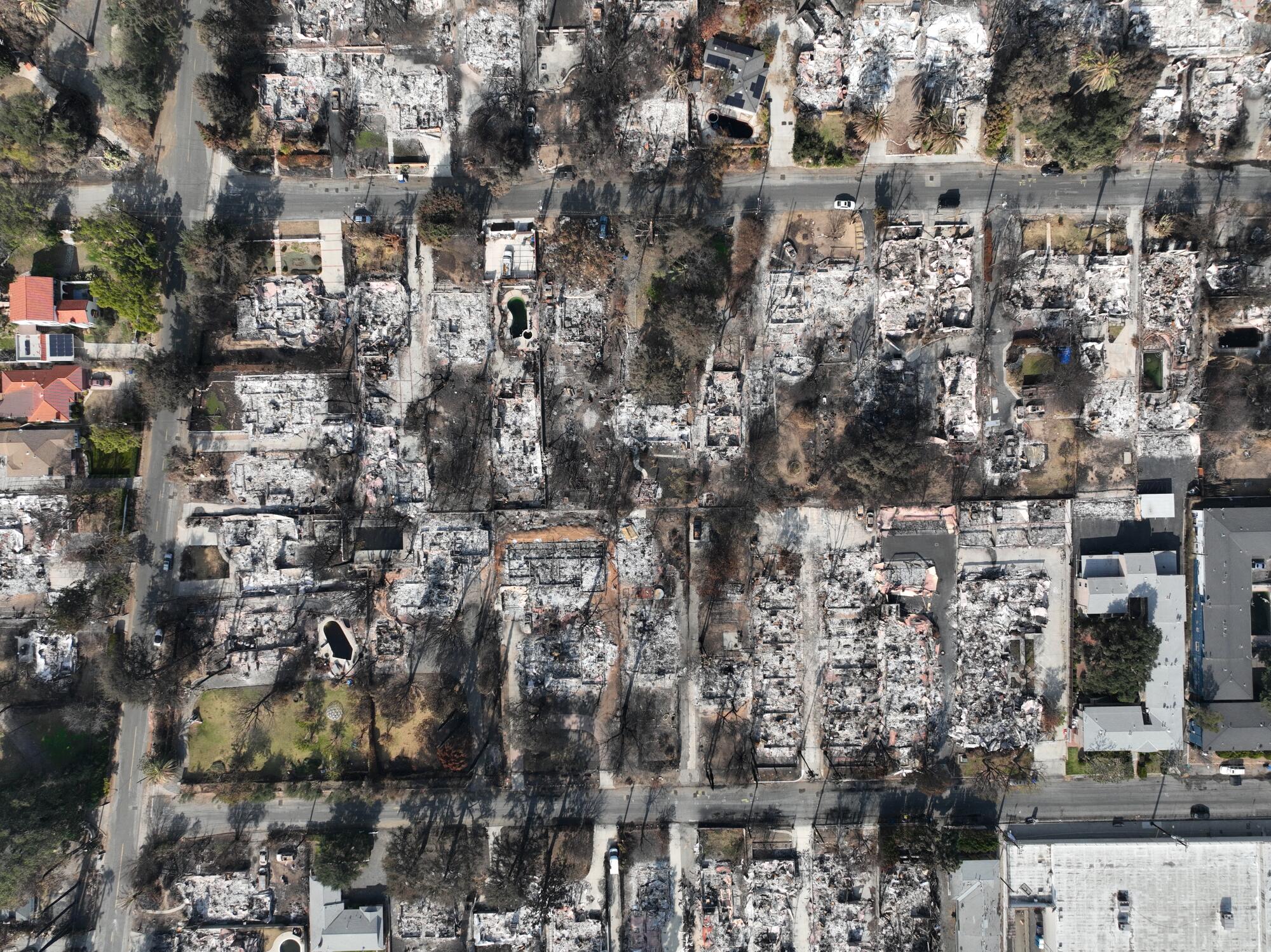
An aerial view of homes destroyed by the Eaton fire along East Palm Street in Altadena.
(Allen J. Schaben / Los Angeles Times)
Everyone in the burn areas — regardless of the potential level of contamination on their property — should ideally have the top layer of their yard scraped and then replaced with a fresh few inches of topsoil, according to Sanjay Mohanty, a civil and environmental engineering professor at UCLA, who is conducting his own soil testing with the multi-university collaboration Community Action Project LA.
For those who can’t afford a full remediation, forgoing the scrape for their yard and just adding new topsoil is the second-best option, he said. This will help dilute any contamination. Planting grass can also help by suppressing dust and locking the soil in place.
Joseph Allen, a professor of exposure assessment science at Harvard University, is working to understand contamination exposures in the burn area as a researcher with the LA Fire HEALTH Study (HEALTH stands for Human Exposure and Long-Term Health). He recommended those living in areas affected by the fires wash their hands after spending time in the yard, remove their shoes before entering their homes, and use a HEPA air filter inside the house to remove any lingering dust.
Purnell, a trained horticulturalist, is confident he can remediate his yard to a safe level. He plans to cover his entire yard with mulch or stones to reduce his potential exposure to the fire-stricken soil.
Some experts say the void left by federal agencies should be filled by the state. Although California has so far not offered to do soil testing for residents affected by the L.A. fires, it has continued its sampling program elsewhere.
About 40 miles north of Los Angeles, crews recently completed state-funded soil testing in the footprint of the Mountain fire, which burned 19,000 acres in Ventura County in November. Sean Smith, the fire’s operation chief and a former 20-year veteran of the California Governor’s Office of Emergency Services, oversaw the work on the Mountain fire.

Julia Fairbanks works on soil sampling at the lot of a house that burned during the Mountain fire in November. Cleanup efforts ramped up in March.
(Michael Owen Baker / For The Times)

Disaster Recovery Experts owner Sean Smith and senior environmental specialist Diane Lamkin stand at the site of a house that burned in the Mountain fire in Camarillo.
(Michael Owen Baker / For The Times)
“I’ve done this 32 times,” said Smith, who in late March was supervising cleanup crews in Ventura County while wearing a helmet covered in stickers representing many of the previous fires on which he’s worked.
“I could never promise that you cleared a parcel without the confirmation sample, regardless of how good the contractor does or how it looks. The proof is over there in that jar.”
Smith said 35 of 133 properties affected by the Mountain fire — 26% — were still contaminated after the initial debris removal. For those properties, he sent crews back to remove another layer of soil and perform another round of testing. The process will continue until the levels of toxic substances meet California safety standards for residential properties, he said.
This approach has been in place for nearly two decades. It was based on what state workers informally called the “3-year-old principle,” meant to describe when a yard would be deemed safe enough for a toddler to play in without concern for toxic substances.
“It really made sense to me, because I would go home on the weekends and watch my kids play in the yard and play in the dirt,” Smith said. “And they have a little place where they use their Tonka trucks and dig. And I’m thinking, ‘Wow, if we didn’t do what we did, and we had a fire, my kids would be digging in something that may or may not be clean.’”
Even without testing, rebuilding is moving forward.
L.A. County and the city have each issued several rebuilding permits, with no soil testing requirement. Hundreds more applications are awaiting review.
The first home to break ground in the Palisades is in the Via Bluffs area, according to Cory Singer, co-owner of the building firm Dolan Design & Build, who is overseeing the work. The company has already contracted with a dozen homeowners planning to rebuild and return.
Singer said he doesn’t fault federal disaster officials for opting not to test the soil in the Eaton and Palisades fire areas, noting that the scale of the fires’ destruction and devastation is unlike anything the agency has had to deal with before. Taking samples from each of 13,500 properties destroyed — all of which would need to be processed, analyzed and turned into reports — could create a huge backlog that would ultimately delay the city’s recovery efforts, he said.
“The government cannot test every single property. I think that’s a pretty reasonable statement.”
Singer advised his clients to pay for their own soil testing, which can cost several thousand dollars.
But others say precautionary soil testing should not be an entitlement.
“It’s going to always leave a question in the public’s mind as to what’s the long-term liability,” said Ghilarducci, the former Cal OES director. “If you don’t know what’s in the soil … is it going to extend the time frames of recovery because people are concerned? Or, down the road, if people get sick, is there going to be some tie back to the fire and the fact that no one in the government is doing the testing that they need to do? Ultimately, I think the homeowner is left on the hook.”
The point of testing, experts say, is not just to find and eliminate contamination. It’s also to give peace of mind to the homeowners whose properties will test clean.
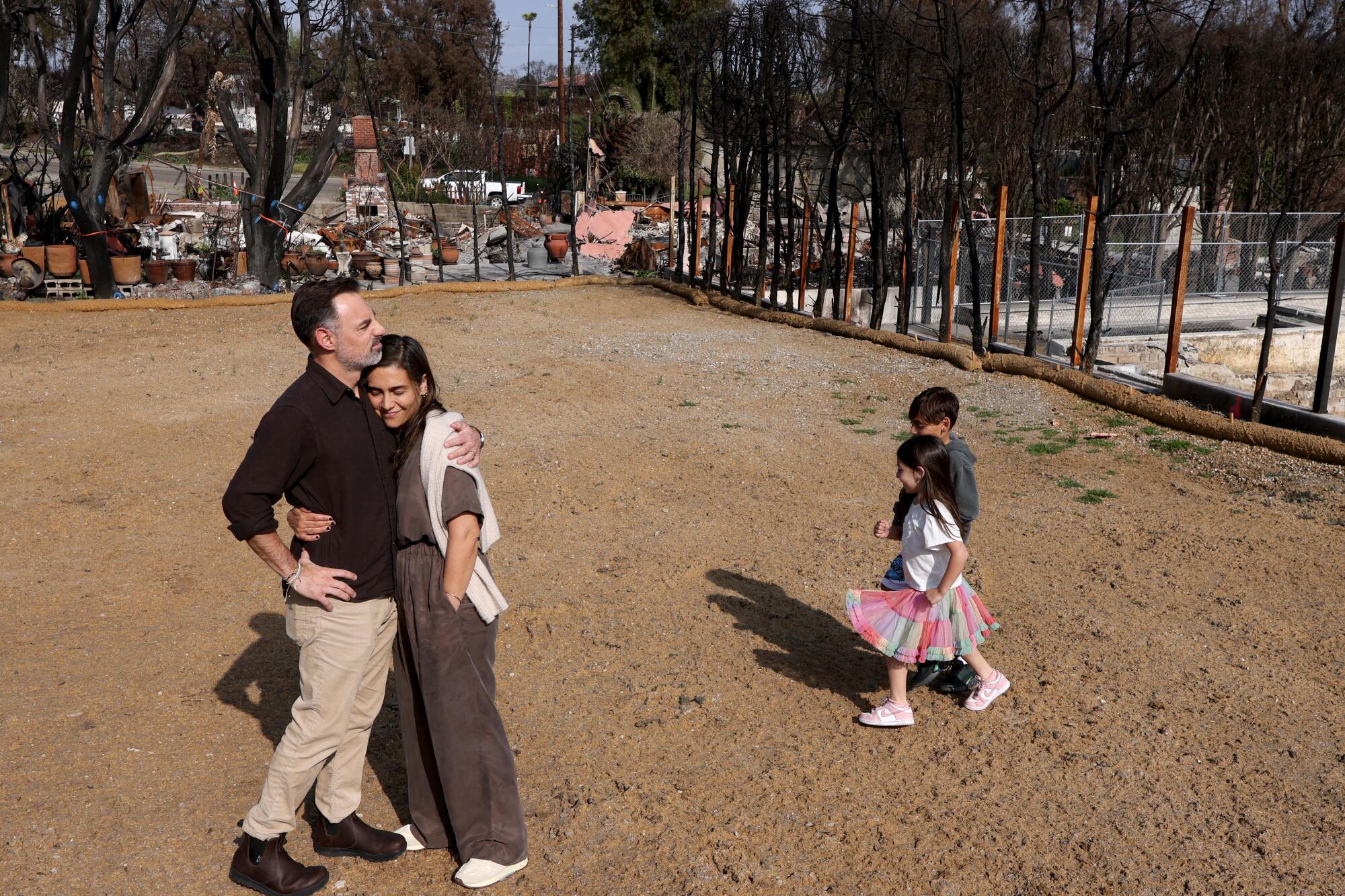
Justin and Mandana Sisco hug while visiting the site where their home once stood in Pacific Palisades. The Siscos had their lot independently tested for toxic substances and were relieved when tests revealed no contamination in the soil.
(Genaro Molina / Los Angeles Times)
Before the firestorm, Mandana Sisco said she lived on what felt like the “best block in the Palisades.” On Fridays, all the elementary schoolers would run down the hill from their classrooms to the beloved corner store for snacks. Every Labor Day, the families would chip in for a block party complete with a taco truck, water balloons and the Fire Department.
Now, day by day, more and more neighbors are deciding to move, as the daunting task and financial burden of rebuilding looms.
When Sisco, with two young kids, learned from The Times that the soil on her property wasn’t contaminated, she said she could finally breathe a sigh of relief. Her family was already determined to rebuild, but the test results offered her a small but meaningful reassurance.
“I take everything as a sign right now,” Sisco said. “It’s just a very hard time, so it’s helpful to have good news … because that’s one thing that just keeps us moving forward.”
Times data journalist Sandhya Kambhampati and staff writers Corinne Purtill and Melody Gutierrez contributed to this report.
Newsletter
Record heat. Raging fires. What are the solutions?
Get Boiling Point, our newsletter about climate change, the environment and building a more sustainable California.
You may occasionally receive promotional content from the Los Angeles Times.
Search
RECENT PRESS RELEASES
Related Post


